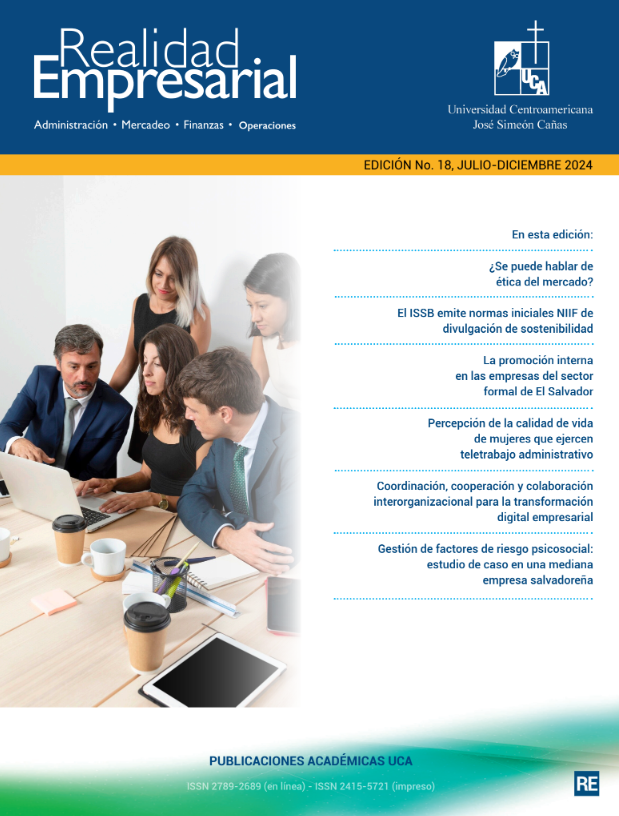Abstract
The main objective of the present study was to examine the perception of quality of work life among women engaged in administrative telecommuting in subcontracting microenterprises. Using a qualitative methodology and phenomenological approach, semi-structured interviews were conducted with 12 women who met the study’s criteria. The interview questions focused on three categories of interest: quality of work life, sociodemographic factors influencing quality of life, and psycho-affective characteristics surrounding quality of work life. The interviews were transcribed and coded into matrices that supported the conceptualization of the experiences shared by the participating women regarding the three categories of interest, and allowed for the identification of emerging categories in their discourses. It was found that women interpret quality of work life in various ways. It was observed how telecommuting aligns with their social construction of women’s roles, reinforcing the social assignment of caregiving tasks and domestic responsibilities. These assignments are deeply internalized by the participants, as they are not questioned but assumed as part of being a working woman. The experiences shared by the interviewed women demonstrate a positive attitude and high motivation towards work, as well as voluntariness and productivity. However, there is also a lack of recognition of their rights regarding the use and respect of their personal, social, and work time, and opportunities for growth. This research highlights the importance of understanding and interpreting different perspectives to improve working conditions and satisfaction in this specific context.
Realidad Empresarial No. 18, 2024: 30-44.
References
American Psychological Association. (2023). 2023 Work in America Survey. Workplaces as engines of psychological health and well-being. https://bit.ly/3tuuwKo
Asamblea Legislativa de El Salvador. (2022). Ley que autoriza el teletrabajo en El Salvador podría ser prorrogada hasta 2023. https://bit.ly/3S2qpyv
Benavides, K. M., Aguilar, G. P., & Benavides, Y. M. (2021). El teletrabajo, valoraciones de las personas trabajadoras en relación con las ventajas y desventajas, percepción de estrés y calidad de vida. Revista Nuevo Humanismo, 9(1), 20. https://doi.org/10.15359/rnh.9-1.1
Bhatti, B. M., Mubarak, S., & Nagalingam, S. (2017). A framework for information security risk management in IT outsourcing. https://aisel.aisnet.org/acis2017/98/
Castellanos, Y. S., Sánchez, S. E., & Santana, A. M. (2014). Trabajo en casa y calidad de vida: Una aproximación conceptual. Cuadernos Hispanoamericanos de Psicología, 14(1), 57-72. https://bit.ly/3S6tZHG
Erazo, M. J. (2020). Teletrabajo en El Salvador. Factibilidad y retos ante la pandemia de Covid-19. San Salvador: Ministerio de Trabajo y Previsión Social. https://bit.ly/3tF4owg
Gentilin, M. (2020). Pasado, presente y futuro del teletrabajo. Reflexiones teóricas sobre un concepto de cincuenta años. ResearchGate. https://bit.ly/414i3cI
Gohoungodji, P., N’Dri, A. B., & Matos, A. L. B. (2023). What makes telework work? Evidence of success factors across two decades of empirical research: A systematic and critical review. The International Journal of Human Resource Management, 34(3), 605-649. https://bit.ly/45vZDUe
González, P., Peiró, J. M., & Bravo, M. J. (1996). Calidad de vida laboral. Tratado de psicología del trabajo, 2, 161-186. https://bit.ly/3NO6Sza
Graham, M., Weale, V., Lambert, K. A., Kinsman, N., Stuckey, R., & Oakman, J. (2021). Working at home: The impacts of COVID-19 on health, family-work-life conflict, gender, and parental responsibilities. Journal of Occupational and Environmental Medicine, 63(11), 938-943. https://bit.ly/45vwAQM
Hernández-Sampieri, R., & Mendoza, C. (2020). Metodología de la investigación: las rutas cuantitativa, cualitativa y mixta. https://n9.cl/9g5kyj
Leka, S., Griffiths, A., & Cox, T. (2004). La organización del trabajo y el estrés: Estrategias sistemáticas de solución de problemas para empleadores, personal directivo y representantes sindicales. Organización Mundial de la Salud. https://bit.ly/48idGgF
Marín, L. G., Urista, V. L., Chacón, L. C., & Rentería, G. A. (2015, enero). Análisis de la carga total de trabajo de las mujeres trabajadoras de la ciudad de Chihuahua y la repercusión en su calidad de vida. Global Conference on Business & Finance Proceedings, 10(1), 1160. https://goo.su/bm2Kx
Ministerio de Trabajo y Previsión Social. (2022). Teletrabajo en El Salvador: Factibilidad y retos ante la pandemia de COVID-19. https://bit.ly/48FPcOo
Modak, M., Ghosh, K. K., & Pathak, K. (2019). A BSC-ANP approach to organizational outsourcing decision support: A case study. Journal of Business Research, 103, 432-447. https://www.sciencedirect.com/science/article/abs/pii/S0148296318300407
Montaño, M. F. (2008). Estado actual de las investigaciones sobre mujer casada, profesional y madre: Del trabajo remunerado al trabajo doméstico. Un estudio sociológico de la familia. Revista Científica Guillermo de Ockham, 6(2), 13-25. https://goo.su/kO89Cqa
Organización Internacional del Trabajo. (2019). El trabajo de cuidados y los trabajadores del cuidado para un futuro con trabajo decente. https://bit.ly/47hizp6
Organización Mundial de la Salud. (2012, 1 de marzo). La Organización Mundial de la Salud para la Calidad de Vida (WHOQOL, por sus siglas en inglés). https://bit.ly/48jAsVt
Organización Mundial de la Salud. (2022, 5 de mayo). Se acaba la emergencia por la pandemia, pero el COVID continúa. https://news.un.org/es/story/2023/05/1520732
Organización de las Naciones Unidas. (s/f). Empoderamiento económico de las mujeres. UN Women – El Salvador. Recuperado el 3 de abril de 2024, de https://elsalvador.unwomen.org/es/nuestro-trabajo/empoderamiento-economico/
Parra, S. P., & Barreto, R. A. (2020). El teletrabajo: Una transformación del entorno laboral y una oportunidad de cambio frente a la prospectiva organizacional. https://bit.ly/48lo7A6
Sampieri, R. H. (2018). Metodología de la investigación: Las rutas cuantitativa, cualitativa y mixta. McGraw-Hill. https://bit.ly/3tOMS8N
Sousa, L. R. M., Lago, E. C., Almeida, C. A. P. L., Moura, L. K. B., & De Mesquita, R. F. (2021). Calidad de vida en el trabajo y salud pública: Estructura dimensional de una escala. Enfermería Global, 20(2), 453-491. https://bit.ly/47fXVpr
Zambrano, N. M., & Zambrano, R. M. (2014, noviembre). La inserción de las mujeres en el mercado laboral. ECA Sinergia, 5(1). https://dialnet.unirioja.es/servlet/articulo?codigo=6197588

This work is licensed under a Creative Commons Attribution-NonCommercial-NoDerivatives 4.0 International License.
Copyright (c) 2024 Diana Alexandra Aguilar Guirola, Raquel Andrea Castillo Rivas, Sandra Gabriela Bonilla Balcaceres






